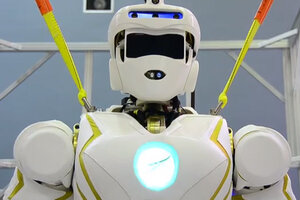Meet Valkyrie, the 'superhero' robot
Valkyrie, a humanoid robot, is the Johnson Space Center’s submission to the DARPA Robotics Challenge.

Is this the rescue robot of the future?
YouTube/IEEE Spectrum
At last: a robot that doesn’t invite immediate premonitions of it turning against us.
“Meet Valkyrie,” says Nicolaus Radford, deputy project manager at the NASA Johnson Space Center’s Dexterous Robotics Lab, in a video from IEEE Spectrum: “Superhero robot.”
Valkyrie, a humanoid robot, is the Johnson Space Center’s submission to the DARPA Robotics Challenge, a long-term competition that will award $2 million to the team that best develops capabilities to operate a rescue robot in a disaster zone. The second part of the competition, and the first time that the robots will spar in the real world, is scheduled for December 20-21 at the Homestead Miami Speedway, in Florida.
Valkyrie is 6’2” and 276 lbs. Its arm-span is 80 inches. It has cameras in its head, abdomen, and knees, and sonar in its middle. All the power it needs is in a battery kept in its backpack. It is white and glossy, and the NASA emblem on its big, broad chest glows a pale, happy blue. It looks like it would fight for good, not evil.
“What more could you want?,” says Mr. Radford. “We really wanted to design an appearance for this robot that when you saw it, you’re going to be like, wow, that’s – that’s awesome.”
In June, 26 robotics teams had competed in the competition’s first round, the Virtual Robotics Challenge. In that round, competitors had used software of their own design to navigate a virtual ATLAS robot through a simulated post-apocalyptic, suburban environment. Big challenges for the teams had included communicating to their virtual robots instructions to turn on a hose.
Next week, in the challenge’s second trial, 17 teams will compete in the real world, commanding their robots to navigate an obstacle course that includes opening a door, ascending a ladder, and removing debris.
Six of these teams, including NASA’s Johnson Space Center, are competing in Track A of the trials, which means that they will be using robots of their own design. In this track, Valkyrie will be pitted against the NASA Jet Propulsion Lab’s RoboSimian Robot, Carnegie Mellon’s Tartan Rescue Robot, Virginia Tech’s Thor Robot, and others.
Track B and C teams will use their own software to operate DARPA’s Atlas robot, a 330-lbs automaton that looks like the proverbial evil counterpart to the new Valkyrie robot.
Track A, B, and C teams are all receiving DARPA funds to furnish their hardware and software designs. Track D teams, which will use their own robots, are receiving no funding from DARPA.
The final trial will take place next December. During that round, competitors will have to get their robots to complete a series of tasks with downgraded communication between them and their robots, in simulation of a disaster zone where communications networks have been disrupted.
The Johnson Space Center’s plans for Valkyrie extend beyond the DARPA competition. This robot's descendants could help us put settlements on Mars, the agency says.
“Likely, NASA will send robots ahead of the astronauts to the planet,” says Radford. “These robots will start preparing the way for the human explorers, and, when the humans arrive, the robots and the humans will work together."

